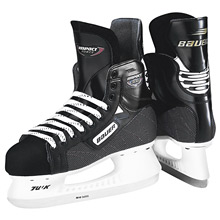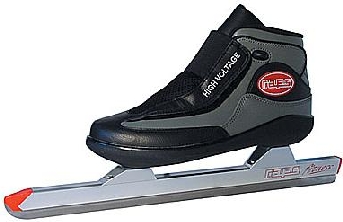Home
History
Skate Design
Forces and Motion
Sources
How
Do Ice Skates Work?
Ice skates are unique in that
they take very little force to achieve a large
amount of motion. The low kinetic coefficient of
friction is the source of this efficiency.
Ice skates were previously thought to melt the ice
due to friction and pressure as they moved,
creating a pocket of water that the skate floated
on. New research has given a new
explanation. The surface of the ice actually
exists in a state that is between a liquid and a
solid. Eric Swanson, a physics professor at
University of Pittsburgh, states "The atoms in
this layer are 100,000 times more mobile than the
atoms in the ice, but they're still 25 times less
mobile than the atoms in water. So it's like
proto-water, and that's what we're really skimming
on" (Roth, 2012). These mobile atoms lead to the
reduced friction between the blade and the ice.
According
to the Law of Conservation of Energy, in a closed system, all energy must
be conserved (Knight, 2013, p. 246). However this
energy can be converted between forms. The moving
ice skates have kinetic energy, the energy of
motion which is then transformed to thermal energy
due to friction. If the coefficient of friction is
lower, less energy will be converted to thermal
energy. The less energy that is converted, the
greater the conservation of kinetic energy and the
greater the efficiency of the ice skate. According
to Newton's first law, an object will continue to
travel at a constant velocity unless acted upon by
an outside force. In this case, friction is the
outside force.
Types
of Ice Skates
Figure
Skates - Figure
skates have a toe pick at the front of each blade.
This allows the skater to stop suddenly and
execute spins or jumps. The bottom edge of the
blade is curved running along the length of the
blade.
Hockey Skates -
These skates lack the toe pick and usually have
more support and protection than figure skates due
to the intensity the hockey usually involves.
These skate are shorter in length and allow for
quick turns. The shorter length also increases the
amount that the blades dig into the ice. This
allows the skater to stop, start, or turn quickly.
Speed
Skates - These skates are much longer than
the previous two types. This extra length allows
the weight of the skater to be spread over a
greater area. This lowers the friction, increasing
the speeds that these skates can achieve. These
skates can travel at speeds over 30 mph (Hutchinson, 2006).
Since these skates are considerably longer, the
turning radius is much larger.
Each of these skates has its own unique qualities
making them effective at achieving high speed,
quick turns, or quick stops.


